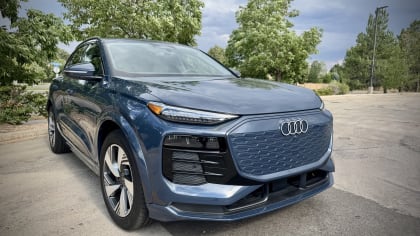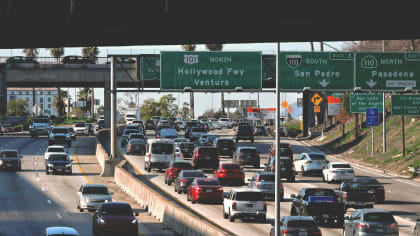PRISMA MAKES ITS MARK ON DESIGN
This article is from our archives and has not been updated and integrated with our "new" site yet... Even so, it's still awesome - so keep reading!
Published on Fri, Oct 8, 2004
By: The LACar Editorial Staff
PRISMA MAKES ITS MARK ON DESIGN
By BILL WRIGHT and ZORAN SEGINA
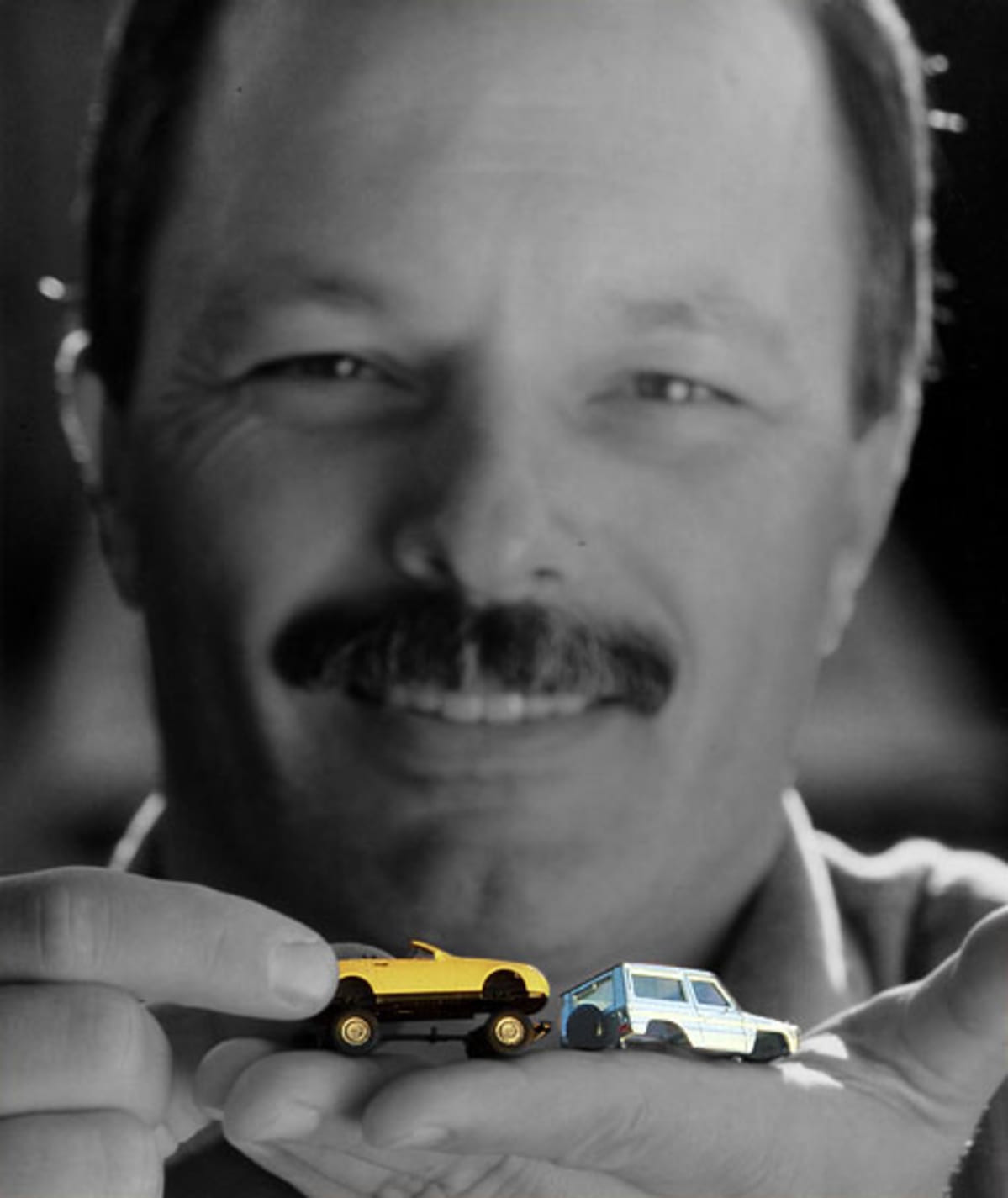
Just as automotive design changes over time, so do the players who make it all happen. As luck would have it, our following article is caught in the middle of just such a change. Gerhard Steinle of Prisma Design International has recently accepted an offer with another design studio within Southern California. While the industry might mourn the loss of another independent operation, we can take comfort knowing that the talent will not be lost. The demise of this facility is the gain for one lucky studio. LA Car wishes Gerhard all the best in his latest undertaking.
One day late in 1989, Bruno Sacco, the head of Mercedes design worldwide, came back from a board meeting and wandered in to see his assistant, Gerhard Steinle; "Gerhard, would you be interested in establishing the first design studio for Mercedes Benz outside of Germany?" Thus began the odyssey for Herr Steinle. It culminated seven years later with his departure from Mercedes Benz and going out on his own to found Prisma Design International Inc. But, we're getting ahead of ourselves here... The first order of business was to figure out where this studio should be. A logical step was to look at the East Coast of the USA. Corporate thinking was that it should be in the USA. Since Mercedes Benz USA is headquartered on the east coast, one would obviously begin the search in New York, New Jersey or the like. Well, when you get off a plane in New York in early January, and the weather is like it was where you got on (gray, wet, slushy, cold), you're not exactly moved to exclaim, "Hallelujah, I won't have to get used to any sort of climate change." No, generally your response is (as was Gerhard's), "You've got to be kidding me...we're heading further west." This being early January, auto show season is in full swing, what with LA and Detroit, so the next stop was Detroit. As Gerhard expressed it, "snow and ice, that was even worse." Or, as LA Car's Zoran Segina summed it up, "New York to Detroit in January, that's like colder without the entertainment!" It was really no surprise that our intrepid explorer continued westward until he ran out of real estate to explore. And voila, he found himself in sunny Southern California. Or as Gerhard puts it, "We got off the plane in LA, the sun was shining, there were palm trees everywhere..." If you're of a certain age, right about now you hear Neil Diamond in the back of your head, "...palm trees grow, the rents are low..."
By the time that Gerhard & company got to California, there were other design
studios representing auto manufacturers already there - most notably, the Japanese,
who by 1990 had been there a long time. Volvo was the first European manufacturer
to open a studio in California, followed by Mercedes, and then in close succession
by BMW and VW/Audi. One might think that the Japanese are in California because
it is the closest point to Japan, but as Gerhard points out, that's only
part of the story. He maintains that the Japanese were the first to recognize
that there is a very special car culture in California, and a much more interesting
market. To the Japanese, it became a point of faith that if a car sold well
in California, you can probably sell it elsewhere, and if it flopped in California,
then you really had to take a hard look before you take it anywhere else. The
infrastructure to support an auto design studio was already in California, along
with the talent. It may seemed to the 'suits' back in Germany that
New York/New Jersey is a good choice, but as Gerhard points out, "...what
kind of car culture is there in New York? They ride in cabs and take the underground."
Eventually, Gerhard and the Mercedes Benz Advanced Design Studio (of which he
was President) came to be located in Irvine. Gerhard was initially on a three-year
contract, which was extended twice for two years each time. All good things
must come to an end (supposedly) and one day the edict came down from high above
(picture in mind's eye a man in a dark trench coat with a monocle, and
Wagnerian music swirling all around, ever louder) "Herr Steinle, sie haben
hier im USA (Editor's note, our correspondent got a little carried away
here). Okay, okay, it was more along the lines of, "Herr Steinle, you've
been here in the USA for seven years, and it is time for you to return to your
rightful place in the corporate structure in Germany.
Think about it; if you had come from the head office of a large German corporation
to Southern California, where you had been running your own show for seven years
pretty much unencumbered by the suits, and now you're faced with the prospect
of returning to the lair of the suits, what would you do? As Gerhard summed
it up, "I had become too accustomed to California, the way of doing business,
and the enthusiasm for cars. Also, I had become far too used to a smaller organization
and wasn't in the mood to go back to spending 60 percent of my time on
corporate politics." The next step was to go out on his own, to 'jump
into the deep end' without the security of the life preserver that a deep
pocketed corporate parent gives you. As one might imagine, those were 'interesting'
early years, and more than a little stressful. So here we are, several years
later, and Prisma Design International is a going concern. We at LA Car thought
that this would be a good time to have a chat with Gerhard Steinle, and get
his views on the present state of auto design.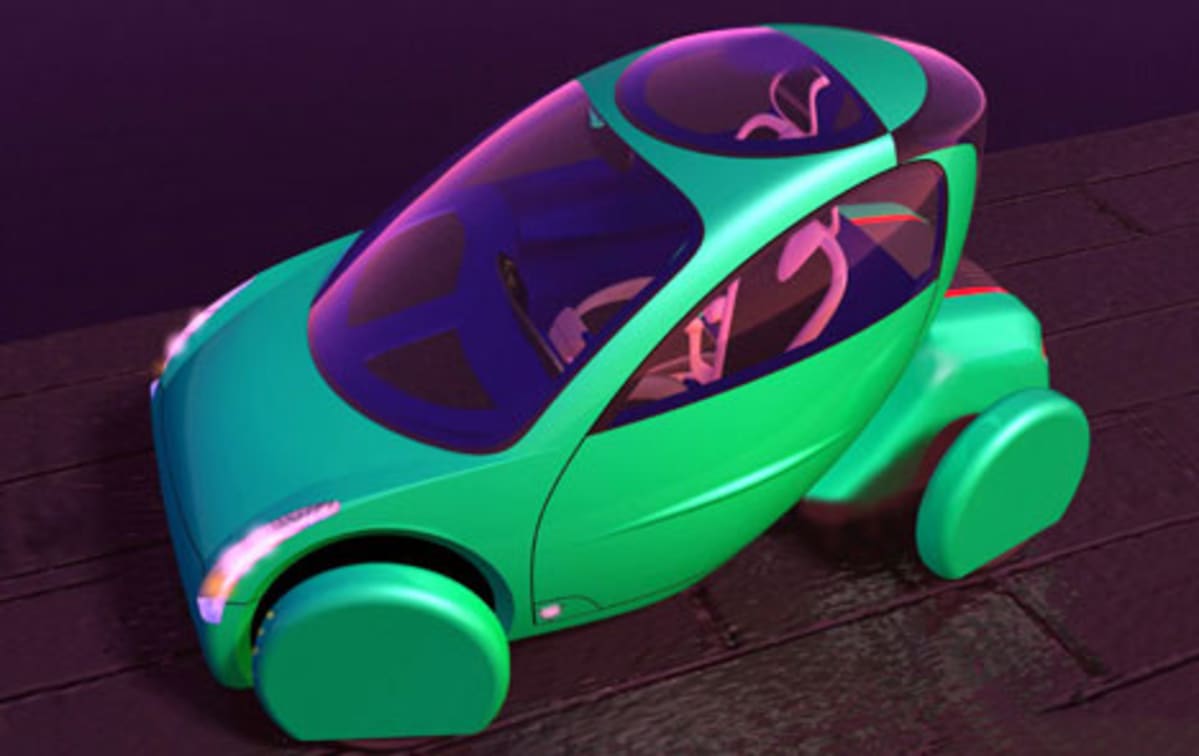
The LA CAR Interview with Gerhard Steinle
Managing Editor Bill Wright and Editor-at-Large Zoran Segina interview Prisma
Design International founder and chief Gerhard Steinle. 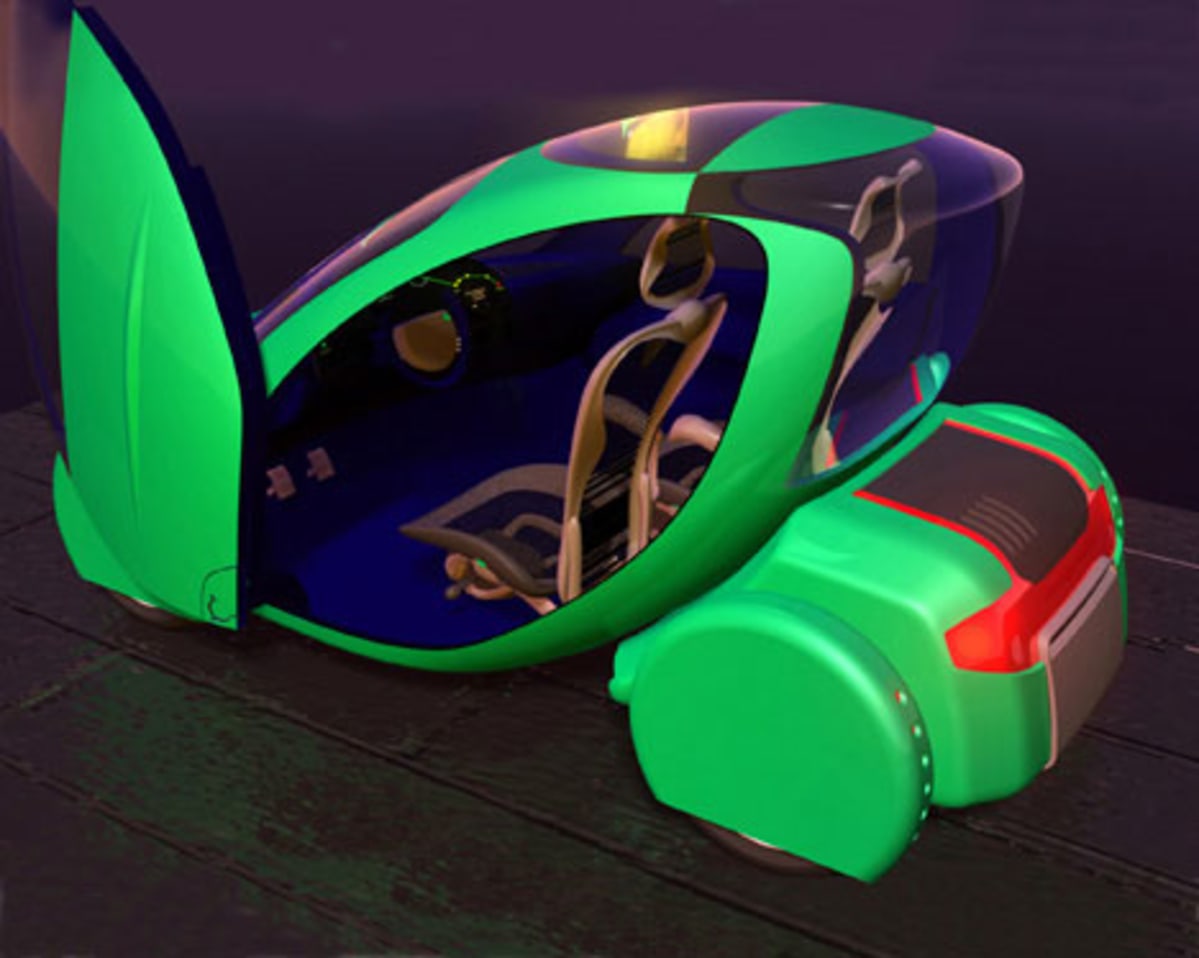
Wright: Are you one of these people who came over from Germany, took a look around, and decided to stay? Steinle: Pretty much. I came over in 1990 from Germany. I was sent over by Mercedes. I was with Mercedes-Benz for over sixteen years altogether. Before I had this position here in California, I was the assistant to Bruno Succo, who was the head of Mercedes design worldwide. So one evening, he came back from a board meeting and asked if I would be interested in establishing the first design studio outside Germany. That's how I came here to California. The location was pretty open. We had discussed the east coast but when I visited New York, New Jersey in early January of 1990, it was as cold and miserable as Germany. So the next step was Detroit and that was worse; it was cold without entertainment. So when I came to LA, the decision was pretty obvious. I looked at the first facility that's owned by Mercedes-Benz in Hollywood. But that wasn't ideal for a design studio, so I ended up in Irvine and moved into a new facility. I started hiring people and acquiring equipment. I was president of Mercedes-Benz Advanced Design for seven years. After those seven years, I wasn't ready anymore to go back to Germany. Mercedes wanted me to go back, but I grew too accustomed to California. Segina: There are many manufacturers - Volvo and Ford being two examples - who have design studios in Southern California. Is that part of the reason why you chose Irvine? Steinle: Actually, the Japanese came to California much earlier. Toyota was the first one. For theJapanese the West Coast is closer to their headquarters. And they figured out that California is the most interesting market. If their design concept is accepted in California, the chances that it will sell worldwide are pretty high. If it is rejected, then they better go back before they try to conquer the entire country or other markets. It makes a lot of sense to be in California, this mega-cultural melting pot. But for us Europeans, the East Coast is closer and has a more European flavor and so MB-USA thought of finding an interesting location on the East Coast. But I thought California made more sense, as the infrastructure for an automotive design studio was here already. The car people are here in California. The Japanese were first, and then Volvo was the first of the Europeans. When we started in Irvine a few months later, BMW bought DesignWorks. Also Volkswagen-Audi established a studio in Simi Valley about the same time. No one really regretted it. I never hear any complaints about being in Southern California. Wright: I understand that Mercedes wants you back in Germany and it is pretty cold there. But how is to transition from being the head of a large established company's design studio to being on your own? Steinle: It wasn't an easy decision, obviously. But I always wanted to try to be my own boss and deal only with clients. I grew up in the corporate structure in Germany; I started as an entry-level exterior designer. I became team leader. And then Sacco's assistant, which I enjoyed a lot. As an assistant I learned to see things from a different angle, the value of other departments, which contribute also a lot to the business. We designers always think we are the most important contributors. It was very educational to deal with other people and get projects accomplished. When I started with a smaller unit far away from the headquarters, I became more independent and was almost my own boss. I really enjoyed that. I wasn't in a mood to return to the headquarters and spend 60 percent of my time in meetings and deal with the politics of a large company. Based on my experience, I knew how to start a company. I knew some of the cost involved and the risks. I thought I was not too old to start something new and try it on my own. Wright: Of course, you've been open for five or six years. What percent of your business is automobile related? Steinle: Over 90 percent. I am an industrial designer by education and I enjoy designing other things as well. But everyone knows me as a car designer. We design a lot of accessories, which is product design in a sense. But eventually, they end up in or on a car. That's an interesting part of our business as well. But designing a car is the most interesting challenge. It is so complex and there are so many issues and problems to solve. There's always a big mountain ahead and you must climb yourself over the top. When you get deeper into automobile design, it is the most enjoyable challenge. Wright: When we were at the Paris Auto Show, we noticed there were very few big cars in Europe like SUVs. Do you think the North American obsession with size will spread to other continents? Steinle: The S-bus was a great achievement for Renault. Very well adapted The Europeans liked the Volkswagen Microbus and later the Vanagon, which took the same parking space as the Beetle, but could sit nine people with a little house on top. The Europeans always like a generous interior space but with a compact outside. In the US, the Americans like the car to look big and impressive. This is a much bigger country than Europe and streets and parking lots are very wide and spacious.
Segina: For Mercedes, at one point they were getting bigger and bigger, that
looked like a boat. But the current generation of S-Class - they look smaller
and lighter.
Steinle: I was Sacco's assistant when decisions were made about the previous
S-Class. I attended all the meetings and I never understood the C140 coupe for
instance, such a big heavy bulky coupe. I thought maybe I was wrong and didn't
get the idea behind it. Sure enough, I never liked the W/C140 very much. The
cars where a treat to drive, especially on the autobahn. But beyond that, it
was the wrong direction the former Mercedes management went. Their decision
was not sensitive to what was going on in the world at the time. The 140 was
created in the late-1980s when everything went well. Then all of a sudden, the
luxury car tax and recession materialized. When the previous S-Class was finally
launched, it was the wrong car at the wrong time.
Wright: I own an '89 S-Class, the 126. I love the look of that car; I have
275,000 miles on that. It was a classic design.
Steinle: I have a W126 coupe with 194,000 miles and I love it.
Wright: But the interior of the present one strikes me as being as big as the
80s. They didn't lose the interior.
Steinle: With the W140, the first interior was so wide that average sized people
couldn't use the armrest, because the door was too far away. A facelift
had to follow quickly with the armrests extended from the door trim. The new
S-Class is a little smaller than the W140, but people feel it is just right.
I like the current S-Class.
Segina: As the baby boomers are aging, there is a prediction that people will
get tired of climbing into big bulky cars.
Steinle: I think station wagons offer the best compromise. They have the handling
of a sedan and a lot of space.
Wright: What do you think of Volvo's XC90?
Steinle: I love it.
Segina: At the same time, the SUV precursor was the Mercedes ML.
Steinle: The ML is a body-on- frame design. I was closely involved with that
development in the beginning. The marketing people were looking for a hybrid
between an SUV and a minivan. They realized that Ford had the Explorer, Jeep
had the Cherokee, Japanese manufacturers like Toyota the Land Cruiser, all very
established already. Mercedes was not the first one to hit the market, as it
was already booming. So why not present something new and different like a sporty
SUV with the interior space and features of a minivan. When I learned about
this idea, I said, "are you crazy, that's not going to work."
People like spaceous interiors but they usually don't like the looks of
a minivan. But the project management pursued the hybrid design. We presented
a proposal on very short notice, but it was rejected, as it was not a hybrid
theme, it was too "sporty". Then the results of the first car clinics
came in, and, of course, the response of the people was negative. So, the project
management later came back to us with the request to present the M-Class as
a true, rugged off-road vehicle. We created a version for the Detroit Auto Show
with extended fenders, big wheels and tires Everyone loved it and we won "Best
in Show" for the first time for Mercedes-Benz by the way. But it was too
late for major changes for the production model and therefore the M-Class still
looks a little too much like a minivan from behind, and not sporty enough.
Segina: In the Auto Show, there used to be these concept cars that never saw
the light of day. But with recent developments, the concept vehicles are almost
100 percent turning into production vehicles. When did the current trend start
and how do you, as a designer, feel about that trend?
Steinle: Chrysler and Tom Gale did a marvelous show when they still had these
appliqué cars running around. But they wanted a strategy to get the public
to forget about what's in the showroom and get excited about the new models
in the pipeline. So they exaggerated some of the features, camouflaged them
a little bit and introduced these concepts to the public and created a huge
interest. It takes people a while to adapt to a new design. But when they see
the concept vehicle and all the photos again and again in magazines, they are
getting used to the design and the features. By the time the car is being launched
people are prepared to buy. And obviously, this paid off tremendously for Chrysler.
The other car manufacturers thought this was an interesting way to do car clinics
with huge audiences, not just a dozen people in a room. So the car shows were
not just focusing on professionals, but the public and how they respond to new
designs and features. Between the car show and the actual launch of the vehicle
there is still a little bit of time to make adjustments and changes, if certain
features are rejected. 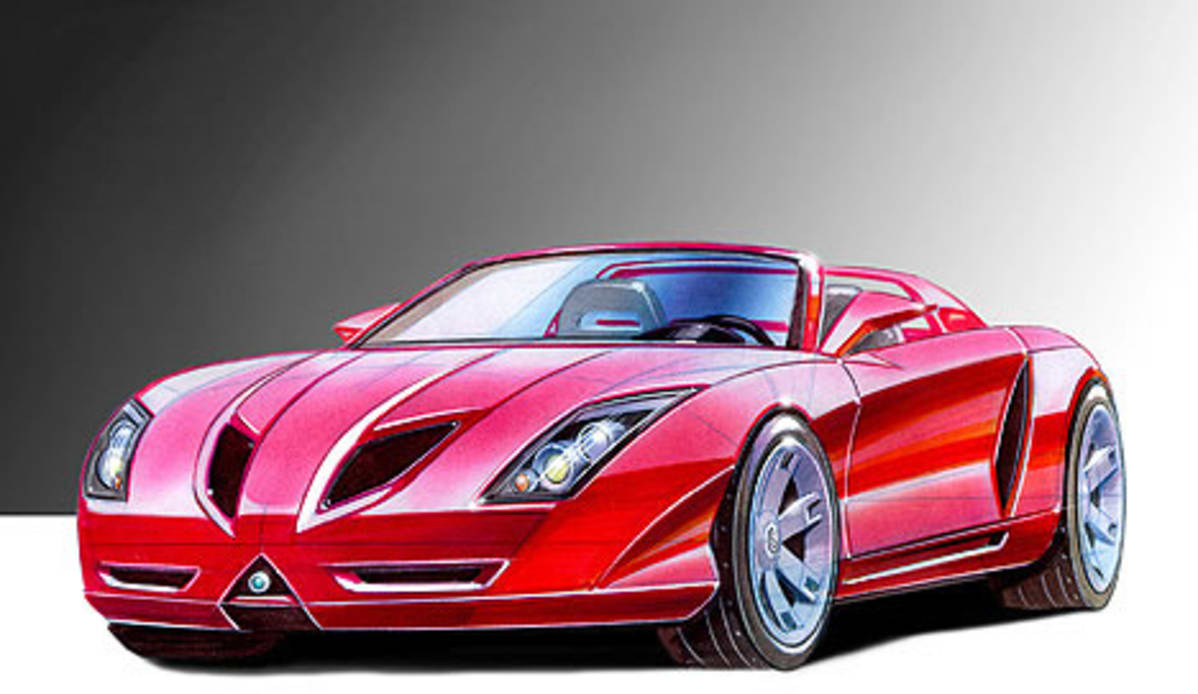
Segina: There's an interesting phenomenon of nostalgia and retro cars.
VW started with the New Beetle, BMW with the Mini, Ford with the Thunderbird,
and so on and so forth. There have been strong criticisms by the designers against
this. What's your opinion on this?
Steinle: The Beetle was kind of cool to reintroduce. J Mays was obviously involved
with Freeman Thomas. After this success story J Mays is kind of repeating himself.
I like the Mustang. The Ford designers did a nice job with it. The Mustang of
the mid-60's was a very successful car and I can see the point of reviving
it. Regarding the Thunderbird, I think Ford should look ahead and come up with
something more futuristic. In general, J Mays does a great job in focusing on
Ford's heritage, but I am greater admirer of Patrick le Quément
at Renault, who's focus is strictly forward oriented.
Segina: In a market like California, it has a tremendous aftermarket -
what some call baubles and bolt-ons. To what extent, as a designer, are you
influenced by the work of aftermarket designers?
Steinle: As a designer, you always keep your eyes and ears open. I go to the
Detroit Auto Show, European shows, as well as the SEMA show. SEMA became very
big in recent years. There's obviously a high demand on the consumer side.
Baby boomers like to be a little bit different. They don't want cookie-cutter
designs. Accessoriesenable a perfect opportunity for manufacturers to differenciate
and allow their customers to personalize their vehicles. That's why the
accessory business is booming. But I wouldn't say that we are influenced
a lot by aftermarket designs.
Segina: But with the laws of physics and space, there is technically only one
exterior design or shape that is most aerodynamic. To what extent are you, as
a designer, limited by having to follow the laws of physics?
Steinle: Actually, the most challenging, interesting and frustrating time for
car designers was in the early 1980s when the wind tunnel really dictated the
shape. If you look at the Mercedes 190, that was a pure wind tunnel body tested
to the excess. With the use of plastic components, the vehicles became lighter
and in conjunction with leaner engines, the fuel consumption became less. The
designers and engineers became also more experienced and found more ways to
optimize the aerodynamics on a vehicle. The underbody panel, the engine compartment,
everything is designed for a low drag coefficient. The trunk doesn't need
to taper that much. So now we see many great compromises. The shapes look different
and each car manufacturer can maintain their corporate look.
Segina: In the old days, 14 or 15-inch wheels were considered relatively large.
But now it's 16- or 18- or 22-inches. From a design perspective, does the
size of the wheel enhance the overall look?
Steinle: Wheels are very important for the overall look of the vehicle. A black
steel rim on a vehicle doesn't look nearly as attractive as nicely polished
alloy wheels. On their sketches designer'suse the finest markers to show
the rubber. It looks great on paper when the wheel shows really big with a low
profile tire. But when I see the car with 22- or 24- inch wheels in reality,
the car doesn't seem to be balanced right When wheels are too big, the
riding comfort drops very low and the performance of the vehicle suffers. I'm
not in favor of 16-inch wheels but there's a fine balance between overdoing
it and being too conservative.
Wright: Do you do much interior design?
Steinle: We work a lot on interiors lately, especially for customers in Asia.
We also did a proposal for Motorola a while ago. We helped them with the design
and concept of their so-called iRadio an Internet based system.
Wright: What do you think of all these toys in the car?
Steinle: It is a huge challenge with all these telematic features. The good
thing is that the components are getting smaller and functions can be combined.
It is a challenge to integrate all these components ergonomically correct. We
have always questioned ourselves for instance: How much information do you really
want to provide to the driver? What is necessary? What helps him/her to operate
the vehicle in a safe and efficient way? What is too distracting?
Wright: What did you think of the BMW I-drive?
Steinle: It was too complicated for most people. For people who work with computers,
etc., it is not so difficult to operate the BMW iDrive, it is pretty logical.
But it takes a while to get used to it.
Segina: A lot of thought came to the 7-Series BMW design. But when the trunk
came out, it was received less than warmly. No moviemaker sets out to make a
bad movie and I'm sure no designer set outs to make a bad design. But is
there a "point of no return?" Have you had experience where the people
knew that something was wrong, but there was no way to go back?
Steinle: That can definitely happen to every company. Quite often the designs
are the results of committees: Design, engineering, marketing, controlling,
the board members everyone has an opinion about design. Sometimes the designers
get frustrated and just follow the guidance of the committee. That's the
worst situation when the designers are no longer enthusiastic about their work.
Later in the process, all of a sudden, someone might realize that the design
should be improved or changed. But then it might be too late and it would be
a tough decision to say, "that's an ugly ducklinglet's toss a
billion dollars worth of investment away and start all over again. 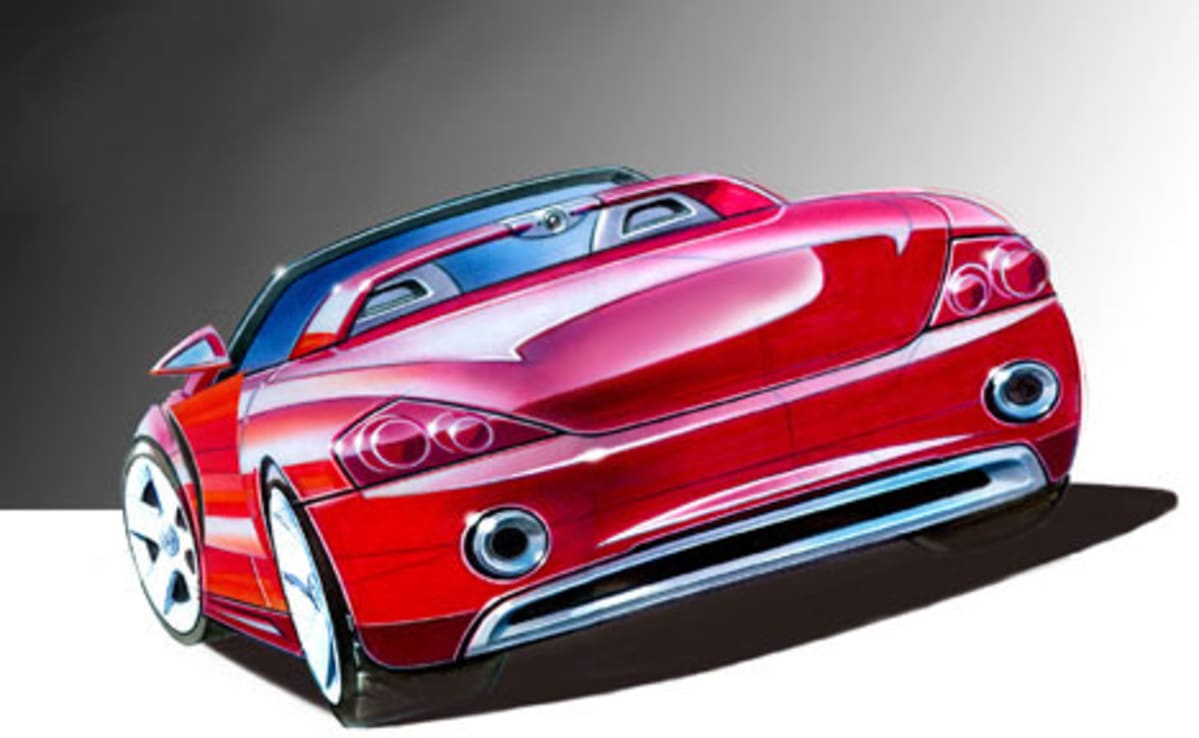
Segina: With the introduction of computer design, has the time between design
and car launching gotten shorter?
Steinle: Much shorter. When I started in 1981, we just started with the first
sketches for the SL. It wasn't launched until 1989, eight years later.
The previous S-Class also took about eight years to develop. Today, a luxury
car manufacturer like Mercedes-Benz might still take about five years to develop
a new model. Other manufacturers take just 24 months. Designing on the computer
saves time, however, modeling clay is still a good medium, and I like to control
the model in 3D.
Segina: If someone approached you with an unlimited budget, what would your
car design be?
Steinle: I like sports cars. That's always a designers' dream. They
are usually fast and look sexy. But I also enjoyed the development of the early
Smart vehicles, which my team in Irvine was involved with. I like the variety
and new challenges.
Segina: When you start a design of a car, how much do you consider sex appeal?
Steinle: I think a car has to look attractive - exterior and interior.
People like to be surrounded by an attractive body. They want to look good in
a car. I have a 911 993 Carrera 4S, which has a very sexy, curvy body. Very
similar to human body shapes. An angular design - like what Cadillac is
pursuing - is interestingbecause of it's stealth character. It is
attractive, but not really sexy. Generally a rounded body has more appeal than
a chiseled body.
Wright: Why is Irvine or Southern California the center of auto design?
Steinle: It is the life style and the weather. When I show photos of the area
here, everyone says "Ahhh, that's California." People here are
enthusiastic about cars. Cars are an important part of their life, their life
style. It is also a car environment with well-maintained roads. There's
little problem with parking, everything is accessible by roads. There are car
nuts who love to run cars, hot rods. The whole infrastructure is here. California
is obviously created around cars.
Wright: When you came to California, did you find yourself changing the way
you look at the automobile?
Steinle: I definitely got a different perspective. In Germany, my car was smaller
but it didn't feel small. When I drove the Mercedes 190 in this California
environment, it looked and felt like a small car. When I drove it in Italy,
it felt like a big luxury car. One of the first issues I got confronted with
when I came over were cup holders and integrated garage door openers In Germany,
there was no Starbucks to get my coffee. It actually never occurred to me that
I should have a cup of coffee handy when I drove 150 miles on the Autobahn.
Wright: How do you sell yourself? What is your approach? Do customers come to
you?
Steinle: I am fortunate to have a lot of big automobile manufacturers amongst
my customers. On the accessory side I work closely with Flex-N-Gate in Michigan.
Over the years I met a lot of people within the industry around the world. That
helps.
Wright: When you came to America, were you shocked at what people do to the
Mercedes-Benz on the street?
Steinle: I got used to chrome wheels but I was kind of shocked when I saw the
golden stars and golden emblems. I never got used to pin stripes. 
Segina: Is there any mutual design influence between the designers for the Chrysler
and the designers for the Mercedes? As cars get more global, will there be less
difference between designs?
Steinle: I have my doubts. The cultures of both companies are still very different
and I think it is wise to keep their individual brand identity.
Wright: What car designs do you admire?
Steinle: I admire brave design approaches like the ones from Renault and BMW.
With brave designs there are higher risks involved. Both companies are taking
risks and some results aren't as successful as others. But in general,
this is the only way to stay on top and lead into the future.
Wright: Do you collaborate with other smaller groups?
Steinle: I've worked a lot with Metalcrafters. What's nice is that
people and companies here in Southern California help each other. There is no
harsh competition.
Wright: Will Europeans get into pick-up trucks?
Steinle: They tried a couple of times but the countries and their infrastructure
are too small. I like pick-up trucks here but I don't know if I want to
drive a full size one in Germany with such a huge turning radius.
Wright: Mostly I'm impressed with your decision to move away from a large
company.
Steinle: I had great job, working as president of Mercedes-Benz Advanced Design.
I worked with my team on the S-Class, E-Class, the SL, etc. and I couldn't
complain about the recognition and compensation. I always knew that the assignment
would end at some point, and I didn't want to return to Germany. It's
hard to leave this area. That's why the decision wasn't so difficult
in the end.
Wright: With a blank check, what could/would you own?
Steinle: A Ferrari is definitely a desirable car. I have a black/black 911 Carrera
4S, one of the last 993 coupes. Therefore I own one of my dream cars already.
However, I also like "practical" cars like the Audi RS6 station wagon.
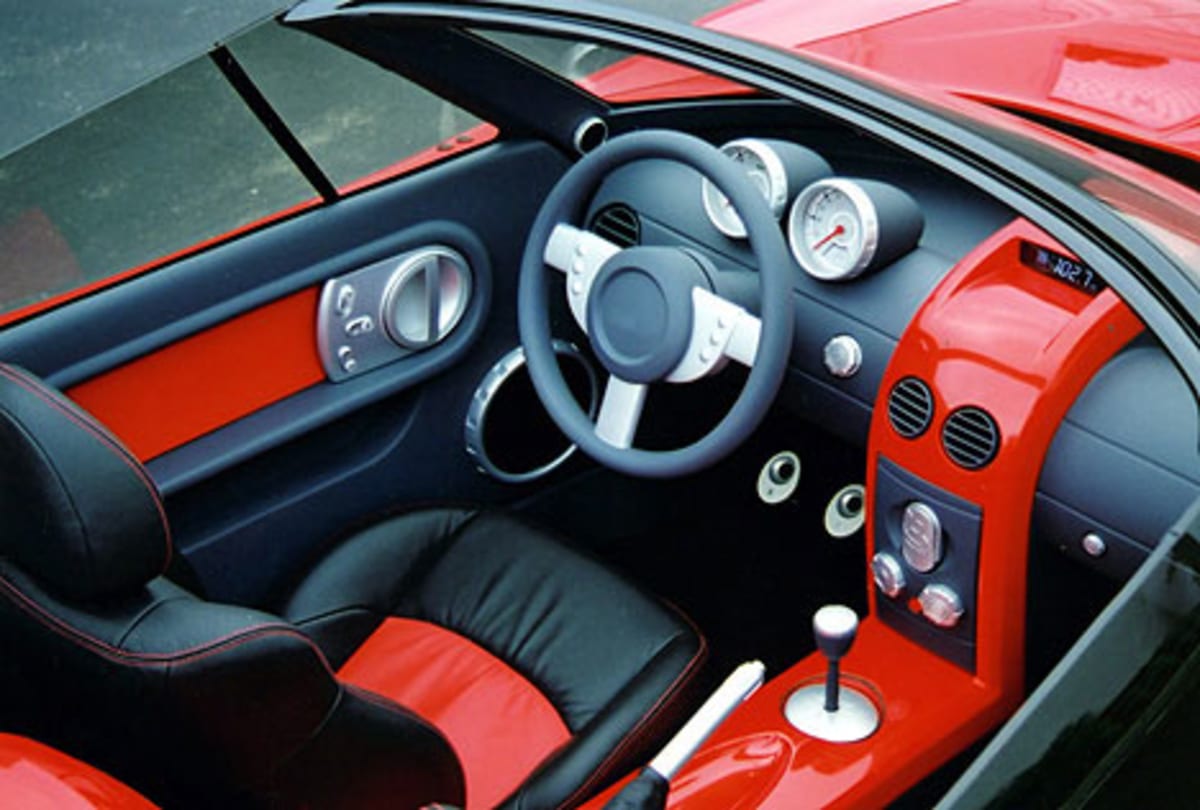
For more on Prisma Design International please go to www.prismadesignintl.com
Editor's Note: A special thanks to Susie Ling who helped contribute to this story.

